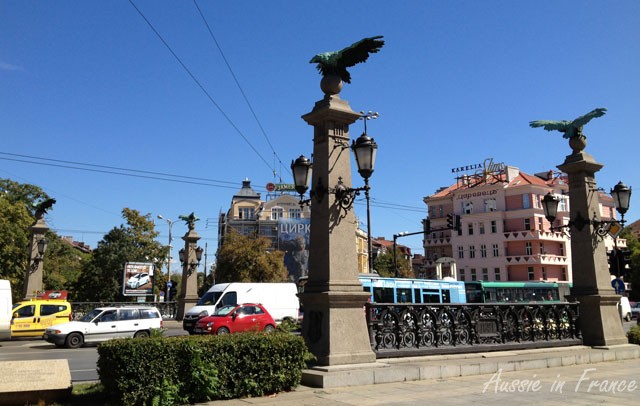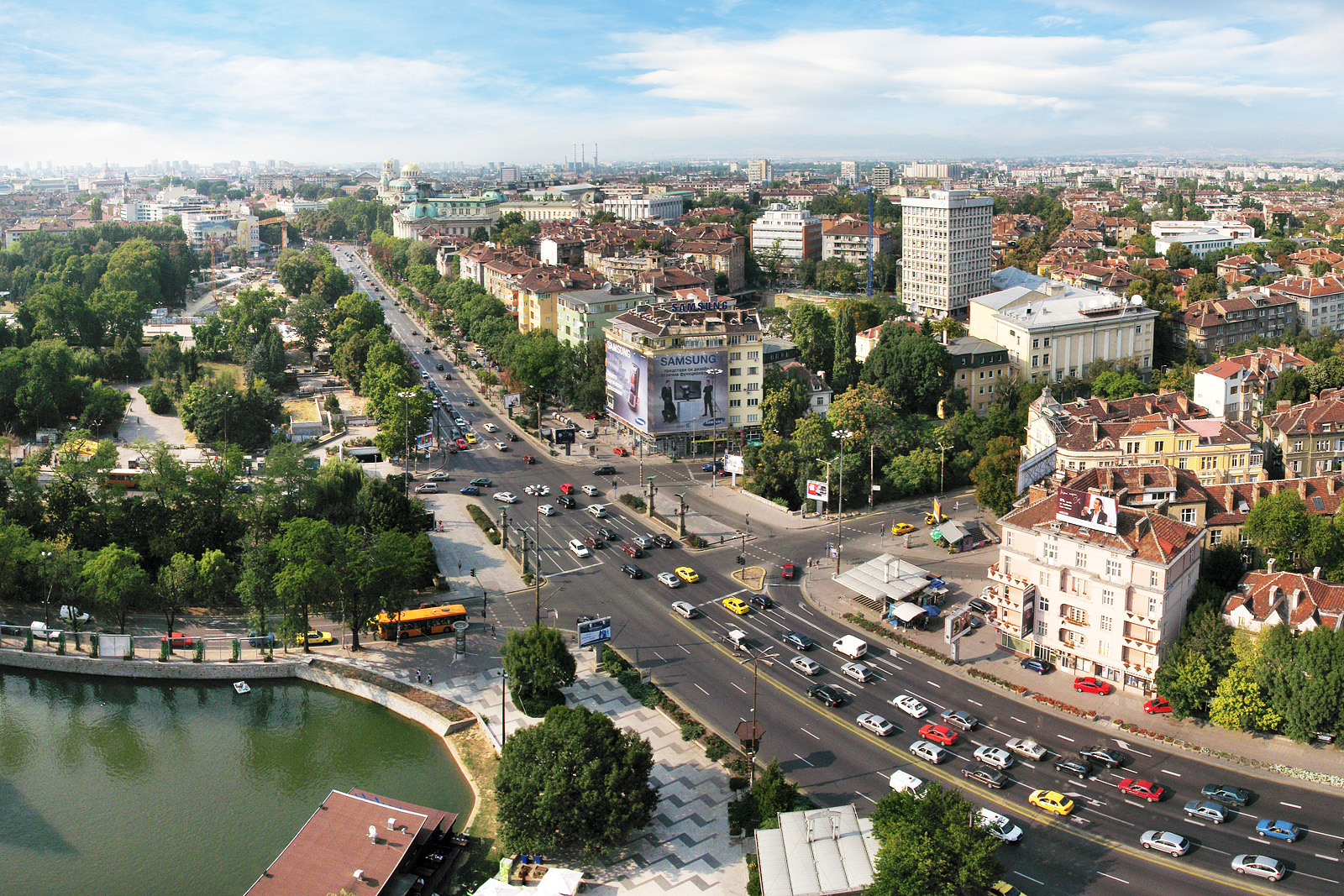Eagles' Bridge, Sofia
The Eagles' Bridge ( Bulgarian Орлов мост / Orlov most) is a bridge in the center of the Bulgarian capital Sofia. It was built from 1889 to 1891. The name derives from the bridge were the four bronze eagle ( Bulg орел / orel for German: Adler ) at the four corners of the bridge. At the time of its construction in 1891, the Eagles' Bridge stood at the edge of town, while now it is in the center of Sofia. On the Eagles' Bridge the largest park in Sofia, the Borisova gradina begins.
The bridge crosses the little river Perlowska reka. At the time of completion of the bridge in 1891, the river marked the eastern outskirts of Sofia. Before there was an old wooden bridge at this point. The barely two meters wide river is now channeled into an artificial concrete bed - very similar to the River Wien in Vienna.
Today, the bridge is one of the most famous bridges in Bulgaria. The eagle bridge is adjacent to the Löwenbrücke the most famous and oldest bridge in Sofia. The bridge is the center of one of the busiest intersections and transportation hubs of Sofia. The place on which the eagle bridge is located, is officially as a space- eagle bridge ( Bulg площад орлов мост / ploschtad Orlov Most) respectively.
The bridge is located directly to the north corner of the park Borisova gradina, near the Ariana lake, the Vasil Levski National Stadium, the monument of the Soviet Army and the main building of the Sofia University.
Description
The Eagles' Bridge is a broad, massive stone bridge with a bow. A span of 15.8 m.
On both sides of the bridge is in each case an ornate, 10 m long cast-iron railings, which also bears the year of completion 1891.
The ends of the handrails are flanked by about 7 m high stone columns. These four square stone pillars ( obelisks, each with two mounted street lamps ) of hewn granite, with classic geometric decoration and ornaments, terminating in a cornice, which is topped with a stone ball. On the stone ball each crowned by a bronze eagle with outspread wings. Four identical Eagle (two are mirror symmetrical to the other two ) in each look direction of the bridge deck of the bridge path. Her head and her gaze is slightly downward and to the side of the bridge. Therefore, they do not act in spite of their outstretched wings as eagles who want to rise straight into the air, but as if they have just landed and the bridge leading over the road with attentive, laterally inverted to the road look suspiciously watching and guarding.
In the lower part of the granite columns is a plaquette with the Bulgarian coat of arms - a border to the left Lion - embedded.
The bridge was several times - at least three times - broadened, as can be seen in numerous photos. When it was built there was the pavement, along with the road, originally between the two cast-iron decorated with a lattice ornament bridge railings of about 10 m in length. Later, the sidewalk was moved to outside the historic bridge railing and between the historic bridge railings was only the roadway. For the lateral boundary of the bridge sidewalks to the bridge edge, another similar bridge railing was installed. Again, later on the northern side of the bridge was built and created an additional track for the tram line, the II from the Tsar Ivan Asen street coming over the bridge, towards the university was. Early on there was a tram (no. 15 and 16), who drove from the city center until shortly before the Eagles' Bridge. 1970 Tsarigradsko Schose was widened and in this context, the bridge was widened by the northern bridge railing was added. In addition, the pedestrian tunnel under the Tsarigradsko Schose was built ( on the southeast side of the bridge ). The eagle bridge was redesigned again in 1991. Among others, this or a little later the tram tracks away, as in the street Tsar Asen II Ivan and on the Boulevard Tsar Osvoboditel to university.
Currently, the two historic bridge railing at a distance of about 30 m from each other. Between them run out of town four lanes and three lanes into town. At the north end of the bridge still runs another road, there were once the tram tracks laid, which comes from the street Tsar Oswovboditel. The side railing of the sidewalk, towards the river, is now on both sides in a very simple and inexpensive design.
The Boulevard Ewlogi and Christo Georgiewi tick the Adler bridge ( бул. Евлоги и Христо Георгиеви ), which runs on both sides of Perlowska reka, and the Tsarigradsko Schose ( from the east ), which leads then to the west to the city center and the name Boulevard Tsar Osvoboditel bears. Because of both sides of the Perlowska reka running boulevards Ewlogi and Christo Georgiewi the intersection is designed as double crossing, where the actual eagle bridge is between two intersections.
At the bridge crossing also opens the small side street Tsar Ivan Asen II. If you Schose from southeast Coming on the scale as highway Tsarigradsko moves to the Sofia city center, the Eagles' Bridge is the first road crossing, about which one goes into the actual city center.
All day long the traffic jams on the bridge crossing, as the populous residential area of the satellite towns (including Mladost 1 to 4) in the east of Sofia are and are mostly accessible via the Eagles' Bridge and the underlying Tsarigradsko Schose. Consequently route 14 bus lines on the Eagles' Bridge. A very busy connecting stop is located directly behind the bridge on the Tsarigradsko Schose. Even the airport Sofia to the east of the city center is accessible via the Eagles' Bridge. Also via this bridge the long-distance transport in the eastern cities of the country - Plovdiv is 150 km to the east. About the Eagle Bridge and the Tsarigradsko Schose the road leads to the highway A1 Trakija that connects Sofia with the Black Sea city of Burgas.
The river bends 30 m behind the northeast side of the bridge by 30 ° to the right.
History
Sofia was declared capital in 1879 of the Principality of Bulgaria. In the following years was the construction of many representative buildings, including the Eagles' Bridge, begun to catch up in terms of the townscape of Europe's cities. The Sofia City Council decided in 1888 to build the bridge as symbolic eastern entrance to the new Bulgarian capital. At this point, until then had been only an old wooden bridge that marked the eastern boundary of Sofia. There, the road began to Constantinople Opel ( now Istanbul ), called in Bulgaria Tsarigrad - the city of the Tsars - the Eastern Roman emperors and Ottoman sultans.
Lack sufficient trained Bulgarian experts, appropriate foreigners undertook the city council, as with many other construction projects end of the 19th century in Sofia, for the fulfillment of this task. ( † 1905 chief architect of Sofia) and Václav prošek, entrusted to an engineer and also co-owners of the nearby brewery prošek with the design of the bridge in this case, the Czechs Antonín Kolář were. It was built to bridge then by architect Václav prošek, as well as his brother Josef prošek and his cousins Bogdan prosecco prosecco and Jiří, who was an engineer. Václav prošek had similar Lions Bridge ( built 1888-1891 ) designed and built in 1889. The construction of the Eagles' Bridge ( built 1889-1891 ) was completed in 1891, the same year as the completion of almost identical Löwenbrücke.
The design and development of all metal elements for the Eagles' Bridge - the four bronze eagle and the iron railings - were executed by the Viennese firm Rudolph Philipp Waagner (now Waagner -Biro ). The works of this company also decorate other architectural monuments in Sofia, such as Levski monument, which was also designed by Antonín Kolář and prosecco, the lion bridge, fencing of the city park Sofia, Tsar Palace, which now houses the National Art Gallery and the Ethnographic Museum. Likewise, the company also has a built Waagner the Monument of Freedom in the central Bulgarian town of Sevlievo. The company had already been built in 1898, the Bulgarian Orthodox "iron church " Sankt Stefan Istanbul.
The Eagles are a symbol of freedom for the exiled martyr. The Eagles' Bridge was built as a symbol of freedom, since the Sofia at this point in March 1878 ( the Treaty of San Stefano was closed on March 3, 1878), immediately after the liberation of Bulgaria in 1878, consisting of Diyarbakır have returned to Asia Minor exiled revolutionaries of liberation struggle have welcomed. These released prisoners of national resistance - including the April Uprising of 1876 - had risen against the oppression of the Bulgarians in the Ottoman Empire. The returned surviving Bulgarian freedom fighters were from the Sofiotern at the site of today's Eagles' Bridge, eastern Sofia city limits on the road to Istanbul ( Bulg Tsarigrad; therefore Tsarigradsko Schose ), solemnly welcomed with bread and salt before adding them to the place Kafene bashi (now Slaveikov space ) as victorious heroes were celebrated. The Russian governor of the provisional Russian civil administration of Sofia (1878 - 1879) Pyotr Alabin (Russian Пётр Владимирович Алабин; Bulg Пьотър Владимирович Алабин ) was at this reception there.
The Eagles' Bridge and the Lion's Bridge have many similarities:
- Its construction was completed in 1891
- They were configured by the Czech engineer Václav prošek. However, some sources attribute the planning of the Lion's Bridge to the Czech architect Antonín Kolář, who was an employee of the municipality of Sofia at that time.
- They bridge the two largest rivers in the city of Sofia and the Sofiaebene.
After its completion at the end of the 19th century, both bridges were lonely at the city limits: the Eagles' Bridge on the east and the Lions Bridge on the northern outskirts of Sofia. The city fathers wanted Sofia lift in cultural terms with the construction of bridges and numerous other prestigious new buildings of that time to the European level.
In their time, the bronze eagle ( respectively the Bronze Lion at the Lion's Bridge ) was a sensation in Sofia and went a long time the public attention. However, the Spirits were upset to the construction costs for the two bridges, since they were considered superfluous luxury. The construction of the Adlerbrücke cost 80,000 Goldlewa, while the lion bridge cost 260,000 Goldlewa. Previously took the Sofia their regular walks along the boulevard Tsar Osvoboditel to Eagle Bridge and possibly even further into the park Borisova gradina.
In 1970, as part of the widening of the Tsarigradsko Chaussee (then it was called Lenin Avenue ) widened the bridge by the northern side of the bridge was laid.
One of the bridge columns with an eagle is depicted on the back of the Bulgarian 20 leva - form ( year of issue 1999 and 2007 ).









